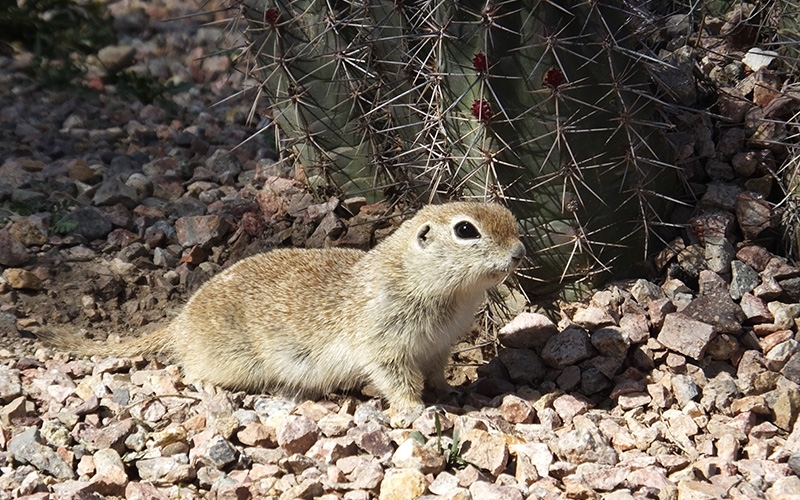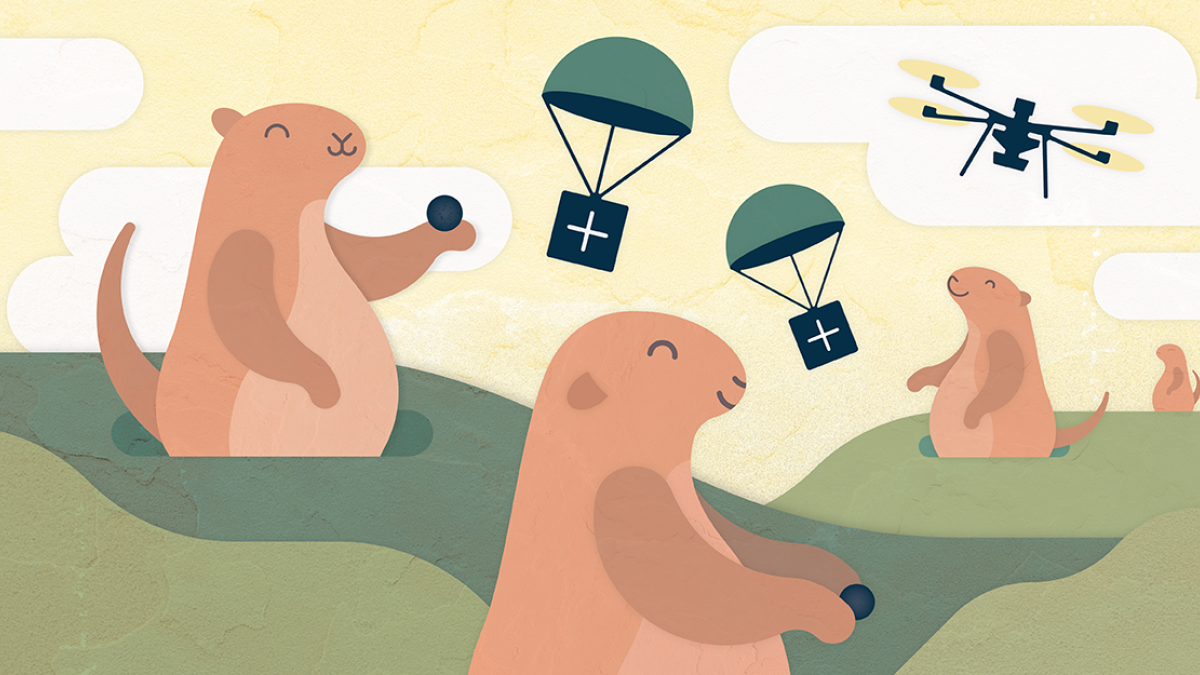When inventing the incandescent light bulb, Thomas Edison tested thousands of materials before finding the carbon filament that worked. The road to innovation might start with a single light-bulb moment, but arriving at a successful solution usually involves multiple stops and starts and changes in direction.
It is also a road best traveled with others. That’s why, when the Arizona Game and Fish Department (AZGFD) was looking to protect endangered species while preserving delicate habitats, they reached out to Arizona State University researchers for help.
The problem at hand
Spreading from northern Mexico all the way to southern Canada, prairie dog colonies cover a broad swath of North America’s grasslands. Equally widespread is the sylvatic plague, a flea-borne bacterial disease that can decimate prairie dog colonies. Outbreaks can kill upwards of 90% of their populations and cause local extinctions.
Prairie dogs are often seen as a nuisance, particularly to farmers and ranchers, because they dig holes and feed on plants. But these unassuming rodents are vitally important to the environment. In fact, they are considered a keystone species — they play critical roles in their ecosystems that cannot be replaced if they disappear.
Protecting these animals and the entire ecosystem they support is an urgent goal of Arizona Game and Fish.
As such a vital species, any threat to prairie dogs is a threat to other species as well, such as the endangered black-footed ferret, North America’s only native ferret species.

A black-footed ferret, North America’s only native ferret species.
Holly Hicks, a small mammals biologist at Arizona’s Game and Fish Department, has worked with prairie dogs since 2007.
“You can't work with ferrets without working with prairie dogs,” Hicks says. “They use their burrows for shelter. Ninety percent of their diet is prairie dogs.”
The good news is that there is a vaccine available that can protect both ferrets and prairie dogs from the plague. But while AZGFD inoculates the comparatively few ferrets by hand, applying the same approach for prairie dogs is out of the question.
“There are millions of them that live in these large grasslands,” Hicks says. “The idea of being able to capture each individual and inject them with something is not reasonable.”
Instead, they feed small peanut butter-flavored pellets mixed with trace amounts of a sylvatic plague vaccine to prairie dogs, making the immunization process simpler.
However, distributing these pellets to prairie dogs created another complication: Biologists would have to travel through multi-acre wide colonies to feed vaccine pellets to prairie dogs while also maintaining the delicate ecosystem they inhabit.
“Here in the Southwest, our grasslands are a little bit more delicate than what you would find in Montana. In fact, in a couple of the areas we do a lot of our prairie dog work in, they don't even allow things like ATVs to be used because it's just too destructive to the ground,” Hicks says.
AZGFD needed to precisely deliver a large amount of the sylvatic plague vaccines across a wide range without disturbing a delicate ecosystem. To do this, they turned to ASU’s DREAMS (Distributed Robotic Exploration and Mapping Systems) Laboratory for support.
DREAMing up a custom solution
To assist AZGFD with the goal of efficiently vaccinating prairie dog colonies in northern regions of the state, the lab, which uses precision mapping technology to observe environmental and biological processes, created a mapping system and a “triple-shooter” attachment for a drone contracted by ASURE, ASU’s applied research and development team.
“Game and fish needed to make a more precise, scaled system that could throw three pellets at a time, which meant that they needed a more nuanced, autonomous system,” says Jnaneshwar Das, an assistant research professor in the Center for Global Discovery and Conservation Science who leads the DREAMS Lab.
The drone would enable them to manage the spread of the plague from above — preserving the prairie dog’s grassland habitat.

Prairie dogs are considered a keystone species.
“The flight controller hardware on the drone, which is commanded to do a lawnmower survey, is also tasked at certain GPS coordinates to precisely release three pellets during a mission, one straight down, two sideways,” says Das, who is also a research assistant professor in the School of Earth and Space Exploration.
While the drone is launching pellets, it also provides geospatial data, which can then be used to analyze the spread and success of the vaccine pellets. However, even if nothing is launched, the system can still provide valuable information.
“As a drone flies, if we map the topography and trend undulations, we can also map individual rocks — their orientation, size — soils and shrubs, using the drones,” Das says. “So you have done a mission without launching any pellets, but you now have a terrain map of vegetation.”
With this data, it’s easier to perform targeted launches and ensure that prairie dogs are actually receiving the vaccines that are being delivered to them.
Devin Keating, a master’s student in geology who works in the DREAMS Lab, took charge of developing the mechanics of the triple-shooter. For Keating, it was an exciting opportunity to integrate his geological background with robotics to create precision technology.
“I’m not an engineer — I’m a geologist,” he says. “So I taught myself how to use the software for CAD design and I taught myself how to use a 3D printer from scratch for this project.”
Turning obstacles into opportunities
While the drone and the triple-shooter delivery system turned out to be exactly what AZGFD needed to administer the vaccine, the pellets themselves were not.
When manufacturing the vaccines, pinpointing the exact concentration necessary to put into each pellet was not feasible on an industrial scale. Lacking the staff and time to create individual pellets themselves, Hicks and AZGFD once again looked for new approaches.
“The pellets not working was maybe a little disheartening, but they didn't give up. They tried something else,” Keating says.
Now, AZGFD’s attention has a new focus: developing a medicine specifically for prairie dogs that will prevent the spread of sylvatic plague-carrying fleas. Delivered in a similar method to the vaccine pellet, this new approach would be akin to your pet’s flea medicine, preventing the plague before it has a chance to spread.
“It's something that they give the animal and then it's in their bloodstream. So when fleas or ticks bite them, they die from consuming the blood,” Hicks says.
Previously, the department would manage the disease by using a method called “dusting,” according to Hicks.
“Essentially, it's walking around with these handheld machines and injecting a deltamethrin insecticide into the burrows of prairie dog colonies to kill fleas,” she says.
However, since the insecticide was such a fine powder and the work was done manually, it was a tedious task that reaped inconsistent results.
The price of dusting an acre of land is about $25, considering the vehicles, biologists and materials needed in the field. However, employing the new drone-based method to mitigate disease spread would increase efficiency and reduce that cost to about $3 an acre.
Additionally, since this new flea medicine would be carried in a similar type of pellet to the original vaccine, the drone and triple-shooter can be used in the same way as before.
In the meantime, Hicks is excited to use the drone’s mapping capabilities, using thermal imaging to detect and track the endangered ferret populations at night, something the team hasn’t been able to do before.
“Any time we can use technology as we move forward to make our lives easier, that's a huge win for everybody because then we can get more work done, and more animals can get protected,” Hicks says.
Top graphic by Andy Keena. Photos courtesy of Shutterstock.
More Science and technology

NASA launches space telescope to chart the sky and millions of galaxies
California’s Vandenberg Space Force Base was the site for Tuesday’s 8:10 p.m. launch of the NASA SPHEREx mission aboard a SpaceX Falcon 9 rocket.The SPHEREx (Spectro-Photometer for the History of the…

ASU-led Southwest Sustainability Innovation Engine funds 8 promising tech startups
In the startup world, tech companies often fall victim to what’s known as the “valley of death” — the gap between technological proof of concept and actual viable product.Aiming to bridge this…

New study explores the link between diet, blood sugar and cancer risk across species
Researchers have long known that diet exerts a profound influence on health, including the risk of developing cancer. A new study, led by researchers at Arizona State University, explores the…


